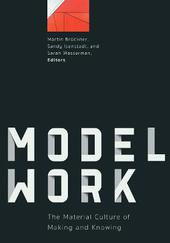
|
Modelwork: The Material Culture of Making and Knowing
Paperback / softback
Main Details
| Title |
Modelwork: The Material Culture of Making and Knowing
|
| Authors and Contributors |
Edited by Martin Bruckner
|
|
Edited by Sandy Isenstadt
|
|
Edited by Sarah Wasserman
|
| Physical Properties |
| Format:Paperback / softback | | Pages:312 | | Dimensions(mm): Height 254,Width 178 |
|
| Category/Genre | Art History
Industrial / commercial art and design
Architectural structure and design |
|---|
| ISBN/Barcode |
9781517910907
|
| Classifications | Dewey:620.0044 |
|---|
| Audience | | General | | Professional & Vocational | |
|---|
| Illustrations |
69 black & white illustrations
|
|
Publishing Details |
| Publisher |
University of Minnesota Press
|
| Imprint |
University of Minnesota Press
|
| Publication Date |
12 October 2021 |
| Publication Country |
United States
|
Description
How making models allows us to recall what was and to discover what still might be Whether looking inward to the intricacies of human anatomy or outward to the furthest recesses of the universe, expanding the boundaries of human inquiry depends to a surprisingly large degree on the making of models. In this wide-ranging volume, scholars from diverse fields examine the interrelationships between a model's material foundations and the otherwise invisible things it gestures toward, underscoring the pivotal role of models in understanding and shaping the world around us. Whether in the form of reproductions, interpretive processes, or constitutive tools, models may bridge the gap between the tangible and the abstract. By focusing on the material aspects of models, including the digital ones that would seem to displace their analogue forebears, these insightful essays ground modeling as a tactile and emphatically humanistic endeavor. With contributions from scholars in the history of science and technology, visual studies, musicology, literary studies, and material culture, this book demonstrates that models serve as invaluable tools across every field of cultural development, both historically and in the present day. Modelwork is unique in calling attention to modeling's duality, a dynamic exchange between imagination and matter. This singular publication shows us how models shape our ability to ascertain the surrounding world and to find new ways to transform it. Contributors: Hilary Bryon, Virginia Tech; Johanna Drucker, UCLA; Seher Erdogan Ford, Temple U; Peter Galison, Harvard U; Lisa Gitelman, New York U; Reed Gochberg, Harvard U; Catherine Newman Howe, Williams College; Christopher J. Lukasik, Purdue U; Martin Scherzinger, New York U; Juliet S. Sperling, U of Washington; Annabel Jane Wharton, Duke U.
Author Biography
Martin Bruckner is professor of English and material culture studies at the University of Delaware. He is author or coeditor of several books, most recently The Social Life of Maps in America, 1750-1860. Sandy Isenstadt is professor and chair of art history at the University of Delaware and author or coeditor of several books, most recently Electric Light: An Architectural History. Sarah Wasserman is associate professor of English and material culture studies at the University of Delaware. She is author of The Death of Things: Ephemera and the American Novel (Minnesota, 2020).
|